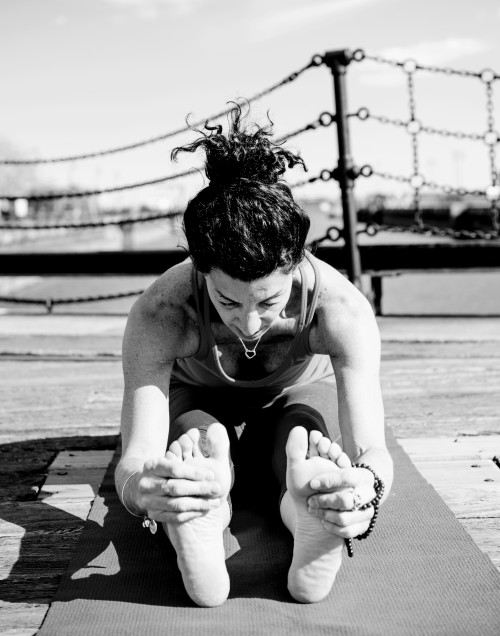
I decided to focus the next few classes on the feet. Sounds obvious, I’m sure because all poses start from the feet. But honestly, there isn’t a lot of cueing that happens at the feet and your foot positions can make a world of difference in how you feel in the overall pose.
Starting just with the basics, you can think of the position of the feet as translating either steadiness or slop all the way up the legs to the rest of the body. It might sound harsh but it’s true. Even in something as fairly basic as a forward fold, without any awareness in the foundation of the body, the arches melt, the knees collapse and the student can feel like they might fall flat on their face. Once you bring some awareness into the feet, the arches lift; the four corners of the feet root; the knees center directly ahead, the inner thigh lines light up and the upper body can relax more comfortably over the legs ( most likely with a little bend through the knees). It can totally transform your poses ( and your teaching).
I’ve had students say to me after classes where I’ve focused on foot cueing that it made a huge difference in their overall feeling of strength. I sometimes feel like when people come to class, they’re so overwhelmed with stimuli from their day, that the feet are the last think they’re thinking about! They’re so consumed by thinking, they can barely feel, let alone focus on something as seemingly minute as the arches of the feet.
One great example of this is the action of the feet when they are flexed. “Dorsiflexion” as it’s anatomically known is the action of decreasing the angle between the top of the foot and the shin. It’s sometimes referred to as “lifting your toes towards your head.” When you do this, you can press back more firmly into your heel. This can create a great sense of stability and strength. Think of this foot position in poses like Seated Forward Fold or Half Moon. One pose is seated, one is standing but in both cases, the flexed foot gives it so much more strength!
One of the best examples of this is found in moving from High to Low Push Up. Not often cued when teaching but very effective is the request to “push the heels back in Low Push Up.” Think of it like this: “From Plank, shift forward to your tip toes; lower halfway down and PUSH YOUR HEELS BACK; flip your feet and press up into Upward Dog; then into Downward Dog.” When you take the time to add this into your instruction, you will see your students’ Low Push Ups have more strength. The upper body is now aided by the lower body.
There are many many more examples. There are also examples where pointing the toes, or “planter flexion” is helpful. Think of poses like Standing Split, Airplane or Dancer’s Pose. These poses call for length more than strength and the pointed toe, like a dancer’s foot, will help you create this sense of length.
Start your class showing students the difference between pointing and flexing and then look for ways to bring these actions and cueing around the feet into your class. See how their focus can shift from their heads to the ground and then up to their heart as they experience the postures more fully.
